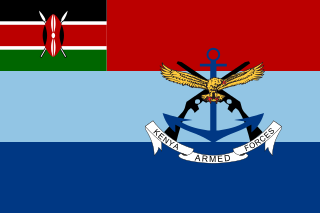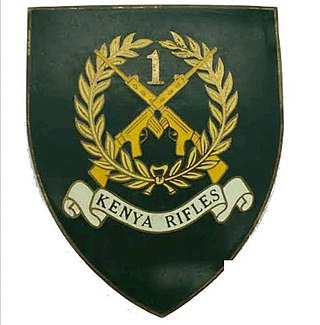
The Kenya Defence Forces (KDF) are the armed forces of the Republic of Kenya. They are made up of the Kenya Army, Kenya Navy, and Kenya Air Force. The current KDF was established, and its composition stipulated, in Article 241 of the 2010 Constitution of Kenya; it is governed by the KDF Act of 2012. Its main mission is the defence and protection of the sovereignty and territorial integrity of Kenya, recruitment to the KDF is done on yearly basis. The President of Kenya is the commander-in-chief of the KDF, and the Chief of Defence Forces is the highest-ranking military officer, and the principal military adviser to the President of Kenya.

160th (Welsh) Brigade or Brigâd 160 (Cymru), is a regional brigade of the British Army that has been in existence since 1908, and saw service during both the First and the Second World Wars, as part of the 53rd (Welsh) Infantry Division. It is a regional command responsible for all of Wales. The Brigade is also regionally aligned with the Eastern European and Central Asian regions as part of defence engagement.

The Duke of Lancaster's Regiment (LANCS) is an infantry regiment of the line within the British Army, part of the King's Division. Headquartered in Preston, it recruits throughout the North West of England. The title of Duke of Lancaster merged with the Crown on the accession of Henry V in 1413 and remains dormant, subject to any future revival. Customarily, however, the Sovereign is referred to as the Duke of Lancaster within Lancashire and in relation to the Duchy of Lancaster, and is the regiment's Colonel in Chief. The Duke of Lancaster's Regiment is the county regiment for Cumbria, Lancashire, Greater Manchester, Merseyside and the Isle of Man, and as such, recruits mainly from these areas.

16 Air Assault Brigade Combat Team, known simply as 16 Air Assault Brigade from 1999 – 2021, is a formation of the British Army predominantly based in Colchester, Essex. It makes up the Air Assault Task Force, a battlegroup held at high readiness, and is the only brigade in the British Army focused on operating via parachute, helicopter and air-landing.

Nanyuki is a market town in Laikipia County of Kenya lying northwest of Mount Kenya along the A2 road and at the terminus of the branch railway from Nairobi. The name is derived from Enyaanyukie Maasai word for resemblance.
25 Flight Army Air Corps is a flight within the British Army's Army Air Corps, currently part of the British Army Training Unit Kenya.

The 3rd Battalion, Parachute Regiment, is a battalion sized formation of the British Army's Parachute Regiment and is a subordinate unit within 16 Air Assault Brigade.

The Kenya Army is the land arm of the Kenya Defence Forces.

The units of the Kenya Army Infantry are the principal fighting arms of the Kenya Army. The primary mission of the Infantry formations is to fight and win land battles within area of operational responsibilities in the defence of the nation against land – based aggression, while the secondary mission is the provision of aid and support to civil authorities in the maintenance of order. The Kenyan School of Infantry (SOI) is located in Isiolo County.

1st Kenya Rifles is an infantry battalion of the Kenya Army. It is a descendant of the pre-independence Kenya British Army formation the Kings African Rifles that was formed before the First World War.

Laikipia Air Base is a Kenya Air Force base located approximately 8 kilometres (5.0 mi) west-northwest of Nanyuki, Kenya.

Queen Elizabeth Barracks is a British Army installation in Strensall, North Yorkshire, England. It is set to close in 2024.

Kenya–United Kingdom relations are bilateral relations between Kenya and the United Kingdom. The interactions between the two states have been positive and friendly since Kenya's independence in 1963. Both the UK and Kenya are members of the Commonwealth of Nations and engage with each other regularly on matters of military, economic and cultural importance. Kenya retains many aspects of British culture and governance, such as continuing to use English within administration, education and the law, driving on the left, hosting a diaspora community of Britons, and having a large Protestant population. The British military continues to play an important role in the country with Kenya hosting the UK's largest base in Africa, which provides vital anti-terrorism training to the Kenyan police. The British royal family, in particular the Queen had very close personal ties to the country. Elizabeth II was in Kenya when she received news that her father King George VI had died, and had made multiple state visits throughout her reign. To mark the 2022 Platinum Jubilee, Prince Edward visited the country to reinforce ties and celebrate Kenya's historic and current relationship with the UK. British tourism and finance are significant contributors to the Kenyan economy, with 100,000 British people visiting the country ever year for its national parks and wildlife.

The page contains the current structure of the British Army. The British Army is currently being reorganised to the Future Soldier structure.

Overseas military bases of the United Kingdom enable the British Armed Forces to conduct expeditionary warfare and maintain a forward presence. Bases tend to be located in or near areas of strategic or diplomatic importance, often used for the build-up or resupply of military forces, as was seen during the 1982 Falklands War and the use of RAF Ascension Island as a staging post. Most of the bases are located on British Overseas Territories or former colonies which retain close diplomatic ties with the British government.
The mission of the Kenya Army Engineers Brigade is to support the Kenya Army in defence of the country against external aggression and to aid civil authority in humanitarian or civic projects.

The Ranger Regiment is a special operations-capable unit of the British Army which was formed on 1 December 2021 under the Future Soldier reform and is part of the Army Special Operations Brigade. It is intended to be used primarily in an unconventional warfare and foreign internal defence capacity in a similar manner to the US Green Berets.
Future Soldier is a reform of the British Army resulting from the Integrated Review of Security, Defence, Development and Foreign Policy published in March 2021. The aim of the reform is to create a more lethal, agile and expeditionary force, able to fight and win wars and to operate in the grey-zone between peace and war. Future Soldier was published on 25 November 2021 and deals with the organizational changes of the British Army, with changes to personnel and equipment were set out in the Defence in a Competitive Age paper published on 22 March 2021.

The Armed forces in Wales are the military bases and organisation in Wales or associated with Wales. This includes servicemen and women from Wales and Welsh regiments and brigades of the British Armed Forces.



















